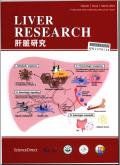Kehuang capsule inhibits MAPK and AKT signaling pathways to mitigate CCl4-induced acute liver injury
IF 2.1
Q2 Medicine
引用次数: 0
Abstract
Background and aims
Kehuang (KH) capsule is an herbal medical product approved for the treatment of liver diseases, including liver injury, in China. However, the mechanism is still unclear. This study aimed to elucidate the protective effects of KH capsule against carbon tetrachloride (CCl4)-induced acute liver injury (ALI) in a murine model.
Methods
Mice were randomly divided into control, model (CCl4), CCl4+KH_Low and CCl4+KH_High group. Liver enzyme levels and histological changes were assessed to evaluate liver injury. Oxidative stress markers and inflammatory cell infiltration in liver tissues were measured. Additionally, network pharmacology was employed to explore the potential mechanisms of KH capsule.
Results
KH capsule significantly reduced serum alanine aminotransferase (ALT) and aspartate aminotransferase (AST) levels, as well as the necrotic area in liver tissue. KH capsule also decreased the infiltration of macrophages and neutrophils, thereby inhibiting the expression of interleukin-6 (IL-6), tumor necrosis factor-alpha (TNF-α), and interleukin-1 beta (IL-1β). Furthermore, KH capsule decreased liver malondialdehyde (MDA) levels and increased superoxide dismutase (SOD) activity. The number of terminal deoxynucleotidyl transferase (TdT)-mediated dUTP nick-end labeling (TUNEL)-positive cells in liver tissue was also reduced. The expression of nuclear factor erythroid 2 related factor 2 (Nrf2) and heme oxygenase-1 (HO-1) proteins was significantly elevated, while the protein expression of cytochrome P450 2E1 (CYP2E1) was significantly reduced. Mass spectrometry identified genistein, galangin, wogonin, skullcapflavone II, and hispidulin as potential active ingredients of KH capsule. Network pharmacology analysis revealed enrichment in the mitogen-activated protein kinase (MAPK) and phosphatidylinositol 3-kinase (PI3K)-protein kinase B (AKT) signaling pathways. Western blot analysis confirmed that KH capsule suppressed AKT, extracellular signal-regulated kinase (ERK), and p38 signaling.
Conclusions
These findings suggest that KH capsule could exert protective effects against CCl4-induced ALI, with the inhibition of MAPK and PI3K-AKT signaling pathways playing a crucial role in its mechanism of action.
可黄胶囊抑制MAPK和AKT信号通路减轻ccl4诱导的急性肝损伤
背景与目的世黄(KH)胶囊是中国批准用于治疗肝脏疾病(包括肝损伤)的草药产品。然而,其机制尚不清楚。本研究旨在阐明KH胶囊对四氯化碳(CCl4)诱导的小鼠急性肝损伤(ALI)的保护作用。方法smice随机分为对照组、模型组(CCl4)、CCl4+KH_Low组和CCl4+KH_High组。评估肝酶水平和组织学变化以评估肝损伤。检测肝组织氧化应激标志物及炎症细胞浸润。此外,采用网络药理学方法探讨KH胶囊的作用机制。结果skh胶囊可显著降低大鼠血清谷丙转氨酶(ALT)和天冬氨酸转氨酶(AST)水平,减少肝组织坏死面积。KH胶囊还能减少巨噬细胞和中性粒细胞的浸润,从而抑制白细胞介素-6 (IL-6)、肿瘤坏死因子-α (TNF-α)和白细胞介素-1β (IL-1β)的表达。此外,KH胶囊降低了肝脏丙二醛(MDA)水平,提高了超氧化物歧化酶(SOD)活性。肝组织中末端脱氧核苷酸转移酶(TdT)介导的dUTP镍端标记(TUNEL)阳性细胞数量也减少。核因子-红细胞2相关因子2 (Nrf2)和血红素加氧酶-1 (HO-1)蛋白表达显著升高,细胞色素P450 2E1 (CYP2E1)蛋白表达显著降低。质谱分析结果表明,染料木素、高良姜素、木犀草素、黄酮II和海鞘苷是KH胶囊的潜在有效成分。网络药理学分析显示丝裂原活化蛋白激酶(MAPK)和磷脂酰肌醇3-激酶(PI3K)-蛋白激酶B (AKT)信号通路富集。Western blot分析证实,KH胶囊抑制AKT、细胞外信号调节激酶(ERK)和p38信号。结论KH胶囊对ccl4诱导的ALI具有保护作用,其作用机制可能与抑制MAPK和PI3K-AKT信号通路有关。
本文章由计算机程序翻译,如有差异,请以英文原文为准。
求助全文
约1分钟内获得全文
求助全文

 求助内容:
求助内容: 应助结果提醒方式:
应助结果提醒方式:


